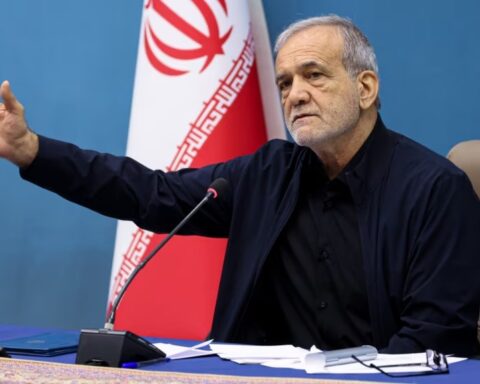ALMATY, Kazakhstan — It’s that time of the year again.
Coal-powered plants and the stoves of residential homes in Central Asia’s largest cities are pumping toxins into the sky, icy roads are thick with slow moving, aging vehicles, and social media chatter is full of talk about how bad the air is and where to buy the best air purifier.
Air pollution, and especially dirty winter air, has long been a problem in the region, but it is now beginning to resemble a catastrophe.
The political will to combat air pollution has traditionally been weak, but with public awareness of the problem growing and the health effects telling, can governments continue to ignore the obvious?
How Bad Is The Problem?
The Kyrgyz capital, Bishkek, has on more than one occasion this month topped the IQ Air website’s rankings for cities with the worst air quality, with average readings of airborne PM 2.5 (PM stands for the particulate matter), comfortably inside the 201-300 range deemed “very unhealthy,” according to the U.S. Environmental Protection Agency’s Air Quality Index.
Kazakhstan’s largest city, Almaty, which is not included in IQ Air’s sample of cities, has posted similar numbers.
The Kazakh capital, Astana, and the Uzbek capital, Tashkent, have been regular fixtures in IQ Air’s Top 20 in recent weeks.
Meanwhile, visual representations of air pollution in the region are abundant, with Almaty and Bishkek’s topographical situations in the bowels of towering mountain ranges allowing for easy aerial shots of cities bathed in a dark gray fug.
On peak smog days, social networks are awash with panic and dark humor as PM 2.5 readings inside apartments soar into the unhealthy bracket.
“An air purifier for half a million [Kazakh tenges — more than $1,000]. Opinions?” asked one Kazakh Twitter user.
“Will it purify a whole street?” replied another, astonished at the high price.

The health impacts are less amusing.
Ermek Ismailov, a Bishkek-based physician, said a growing number of patients complain of migraines and respiratory problems during the winter.
“In the flu season, we see that people’s symptoms are worse. Their immunity is weakening. If coughs used to last two weeks, now we see that people have coughs that last for a month or six weeks,” Ismailov told RFE/RL.
Research backed by UNICEF and presented earlier this year indicated that 112 people died in Bishkek as a result of air pollution between July 1, 2021, and June 30, 2022.
The government, however, cast doubt on the findings.
How Did We Get Here?
Central Asian cities overwhelmingly rely on fossil fuel-based heating systems to provide heat and light to homes.
But globally, they are not alone in this respect.
During Soviet times, the heaviest air pollution was in smaller cities where heavy industry was concentrated.
Since then, urban populations have grown, with the number of cars increasing beyond the capacity of metropoles that grew in a time when only the more privileged had a vehicle to their name.
New settlements on the outskirts of large cities in the region are often unconnected to gas infrastructure, and residents rely on everything from coal to household waste and cheap fabric to keep their stoves burning.
High-rise apartment blocks have mushroomed in city centers and suburbs, blocking airflow.
In Bishkek, these trends have been compounded by a government policy favoring cheaper, dirtier, domestically produced coal over better quality but more expensive imported strains.

Hemmed in by their mountains, Bishkek and Almaty are vulnerable to heavy smog during temperature inversions that see warmer air act like a net, trapping the cooler air and the pollutants from heating sources and transport along with it.
Astana, a steppe city whose population in the past 20 years has tripled to pass 1 million residents, should be better ventilated. But it is also significantly colder, demanding more fuel to heat.
Last year, RFE/RL’s Kazakh Service reported that of 30,000 private houses in the city, only 5,000 were connected to a gas line.
Top-down urban planning in the capital has also left the city with precious few pedestrian zones as more and more cars take to the roads each year.
More Gas, ‘Better’ Coal?
While at least two countries in the region — Kazakhstan and Uzbekistan — are ramping up investment in renewable energy, there are doubts about how quickly wind and solar projects can be scaled up to replace fossil fuel-based energy sources such as coal and natural gas in the region’s growing cities.
For poorer countries, the switch to renewables is harder to afford when offset against subsidized tariffs for electricity and heating that are some of the cheapest in the world.
A more realistic goal in the short term is the transition from coal to gas-powered heating and electricity.
But even that poses challenges.
Uzbekistan, which already looks to gas as an important source of electricity, as well as for heating and to power industry, has seen even deeper than usual shortages of the fuel this winter after anomalously cold weather pushed up demand.
In Kazakhstan, too, there is not enough to go around, a fact that the national gas company QazaqGaz has blamed on low tariffs that disincentivize extraction.
This summer, QazaqGaz Director Sanzhar Zharkeshov said the status quo would need to change if a popular desire to convert a key Almaty power station from coal to natural gas was to be realized.

In Kyrgyzstan, Environment Minister Dinara Kutmanova raised eyebrows last week when she announced at a parliamentary hearing devoted to the smog problem that authorities were seeking a grant of $6.7 billion — more than double the projected budget revenues for this year — to improve air quality.
Less pie in the sky was Kutmanova’s description of plans to build a coal preparation plant at the vast Kara-Keche coal mine that supplies Bishkek’s main heating plant, as well as houses across the country.
The plant would produce coal briquettes that produce less smoke when burned than raw coal, Kutmanova said, adding that the government also planned to replace some of the aging minibuses that dominate the capital’s public transport system with buses and electric taxis.
The Nuclear Option
One clean energy source that has attracted interest among Central Asia’s policymakers amid enthusiastic lobbying from Russia in the last few years is nuclear power.
Uzbekistan and Kazakhstan have stated their intent to build nuclear power plants to ease the pressure on overworked grids and reduce reliance on coal-burning power plants.
Uzbekistan in 2018 reached an agreement with Russian atomic energy company Rosatom to build a nuclear power plant that was expected to be commissioned in 2028, with atomic energy expected to rise from zero to 15 percent of the national energy mix by 2030.
Kazakh authorities had also seemed keen on a deal with Rosatom, but in October the chief of the sovereign wealth fund Samruk Kazyna, Almasadam Satkaliev, expressed support for having an “international consortium” oversee the multibillion-dollar project.
He mentioned Russia, France, and South Korea as potential suppliers of equipment for the plant.
Yet Moscow’s invasion of Ukraine — which, along with unleashing massive devastation to human life and civilian infrastructure, has seen Russian military forces occupy Europe’s largest nuclear power plant, Zaporizhzhya — has at a minimum put question marks over these projects.
Ever a jealous ally, the Kremlin might not react well to being usurped as a partner for the project, which has attracted criticism in Kazakhstan — a country where earthquakes are a real risk and where Soviet-era nuclear weapons-testing has left a bitter legacy.
In an interview with RFE/RL, nuclear politics expert Togzhan Kassenova said Moscow’s actions in Ukraine mean that any notion of Rosatom’s involvement in building a nuclear power plant should be a “nonstarter.”
“A country whose military illegally occupies the nuclear facilities of another sovereign state and creates unprecedented nuclear risks cannot be seen as a reliable partner in the nuclear field,” said Togzhanova, a fellow in the Nuclear Policy Program at the Carnegie Endowment for International Peace.
“A country that will remain under sanctions with limited access to foreign procurement for the foreseeable future is not in a position to build a nuclear power plant.”

















